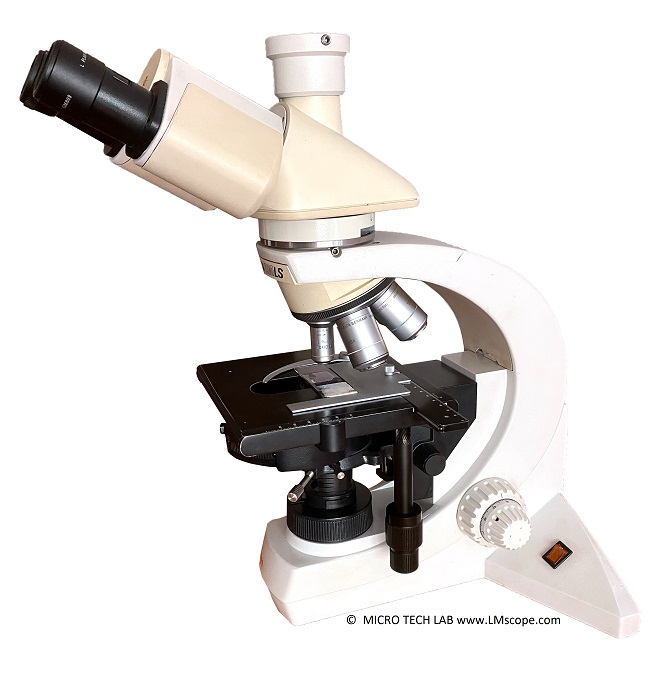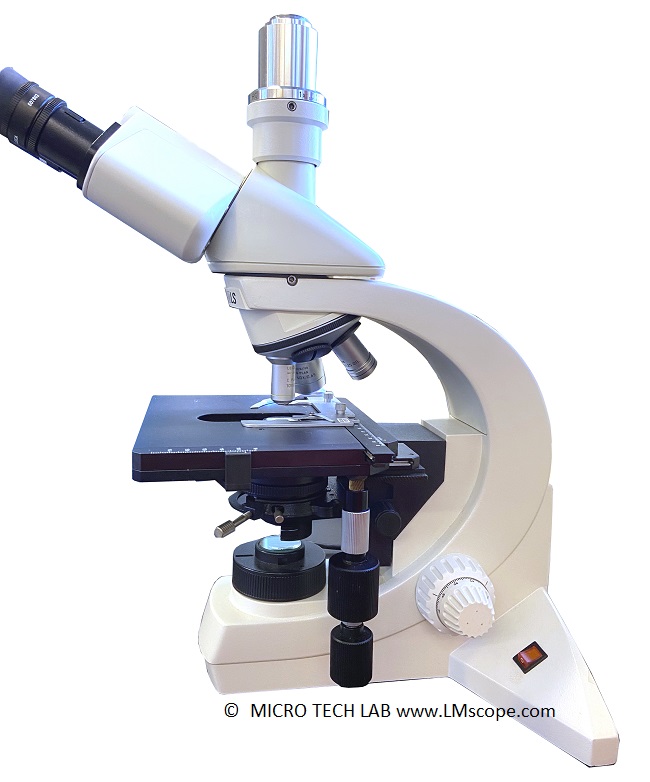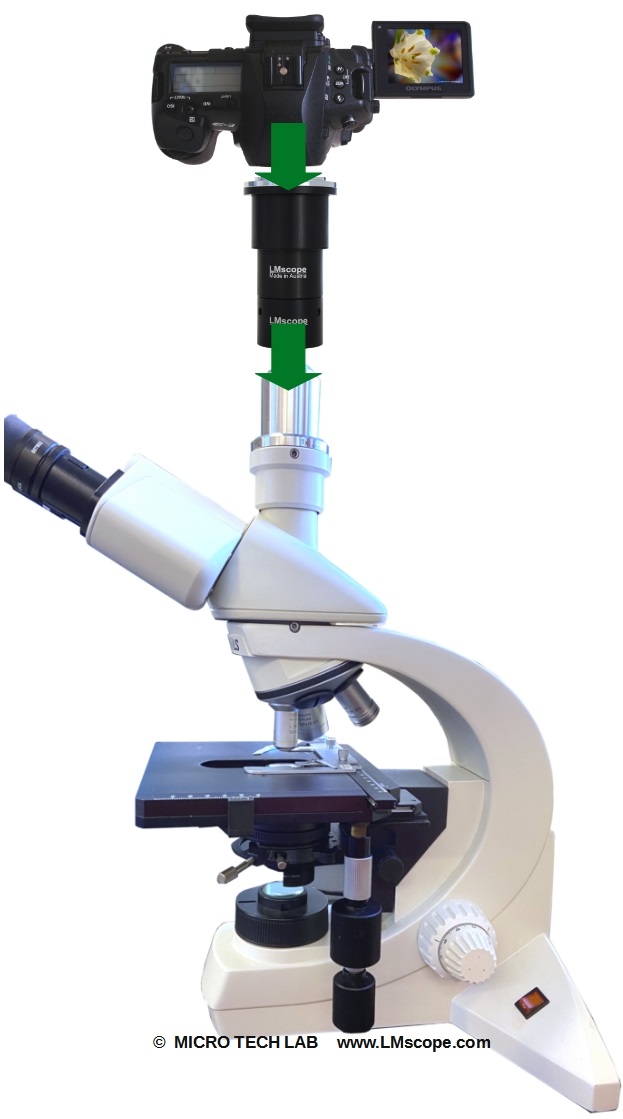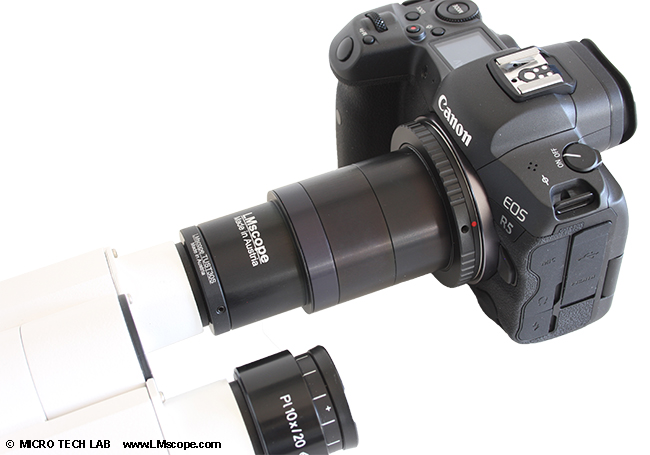

Leica DMLS: add modern digital cameras to this microscope with our LM microscope adapters
Our LM microscope adapters connect your microscope to a wide range of digital cameras (such as mirrorless system cameras, DSLRs or C-mount cameras) in just a few quick and easy steps.

The Leica DMLS is an upright transmitted-light microscope with a modern infinity-corrected optical system. It was introduced to the market in 1996. Because the Leica DMLS features a modular design, it can be configured and expanded very easily, which allows for universal use in a variety of settings. In addition, it was complemented by an extensive range of objectives and accessories. The sturdy construction and quality optical system of the Leica DMLS make it a good fit for latest-generation cameras, which can be attached to the microscope in no time at all with our LM microscope adapters. In good working condition, it is priced at around € 1,600 on the used microscope market.
Key specifications and characteristics of the Leica DMLS:
- Upright transmitted-light microscopes with infinity-corrected optics
- Objectives: variety, from achromatic to plan apochromatic lenses
- Market launch in 1996
- Imaging methods: transmitted light, phase contrast, fluorescence, polarisation
- 5-position objective turret
- Illumination: halogen lamp, mercury or xenon lamp

Photo: Leica DMLS with phototube and C-Mount 1x
The microscope uses Leica objectives with infinity correction and M25 thread; the standard tube lens has a focal length of f=200 mm. A variety of objectives – from achromats to plan apochromats – as well as phase contrast and polarisation lenses are available. The Leica DMLS comes with a 5-fold objective turret and can be enhanced with a range of accessories: a heatable stage, discussion tubes and drawing equipment.
The eyepiece tube (30 mm inside diameter) accommodates a variety of different eyepieces (from 10x/20 to 25x/9.5 B widefield eyepieces).
The microscope usually comes with infinitely adjustable halogen lighting. For reflected light fluorescence applications, it can be equipped with a 12V/100 Watt halogen lamp or a mercury or xenon lamp.
A variety of filters, such as gray, green or daylight filters, are available for the transmitted light unit. The microscope also incorporate Koehler illumination.
The Leica DMLS is available with a number of different tubes, such as a binocular ergo tube with a viewing angle of 0-35 degrees or a trinocular tube with fixed beam splitter. There is also a phototube with 2 ports (50% / 50% split).
The most convenient method of adding a digital camera is to attach it to the phototube of the microscope. Our adapter solution is attached directly to the basic phototube. A precision optical system is integrated into the adapter and allows optical adjustment according to the size of the camera’s sensor. Depending on the camera type and sensor format, we offer different adapter solutions. Camera systems with large sensors achieve the best possible image quality. For more information on making a camera selection, please see our current camera recommendations.

If the microscope does not have a dedicated phototube, it is also possible to attach the camera to the eyepiece tube of the microscope with the corresponding specialised LM adapter solution. The optical quality is equally good with both methods.

Conclusion: The sturdy construction and quality optical system of the Leica DMLS make it an excellent fit for digital cameras. We recommend purchasing a version that has a dedicated phototube (availability permitting). In terms of image quality, plan apochromatic objectives provide the best results. With our LM microscope adapters, almost any camera can be added to the microscope to capture amazing images and video. We offer adapter solutions that work on phototubes as well as eyepiece tubes.
10.08.2022Photography:
Fitting the microscope to digital single-lens reflex (DSLR), mirrorless interchangeable-lens cameras (MILC ), digital single-lens mirrorless (DSLM) or C-mount cameras is easy with our LM digital SLR adapters, which feature a plan achromatic optical system. Our products make it possible to capture top-quality microscope images. To help you select the adapter that is right for your camera, we have set up an online configurator on our website. You can also email us – ideally with attached photographs of your microscope.
Modern DSLR and single-lens mirrorless (DSLM) offer the latest technology and are generally very well suited for microscopy applications. Most of them can be controlled remotely via PC/Mac. Because of their high sales volumes, they offer an excellent price/performance ratio compared to special-purpose microscope cameras.
Features of top DSLR and single-lens mirrorless cameras (DSLM):
- Large, powerful full-frame sensors (36 x 24 mm)
- Sensor resolution of 61 megapixels or 240 megapixels with Pixel Shift technology
- High light sensitivity (ISO 400,000+)
- Extensive dynamic range (up to 15 aperture stops/f-stops)
- Short exposure times (1/8000 second) up to 1/32,000 seconds using the digital shutter
- 4K Ultra HD or 8K Ultra HD video function
- Live video capture on external monitors in ultra HD quality
In most cases, these cameras are significantly more powerful than microscope cameras with smaller sensors (1/2" or 2/3"). On our website you will find our current camera recommendations and a camera ranking which is specifically tailored to microscopy applications.
New LM Digital Adapter for: Sony Alpha 9 III / Nikon Z9 / Nikon Z8 / Sony Alpha 7R V / Sony Alpha 1 II / Sony Alpha 1 / Sony Alpha 9 II (ILCE-9M2) / Sony FX3 Cinema Line / Sony Alpha 9 / Nikon D6 / Canon EOS R3 / Canon EOS R6 Mark II / Canon EOS R8 / Sony Alpha 7R IV / Canon EOS R5 II / Nikon Z6III / Canon EOS R5 / Sony Alpha 7S II / Sony Alpha 7S III / Sony Alpha 7R III / Canon EOS R6 / Nikon Z6 / Nikon Z6II / Sony Alpha 7R II / Nikon Z7 / Nikon Z7II / Canon EOS R / Canon EOS Ra (Astro) / Nikon Z5 / Sony Alpha 7C / Canon EOS RP / Sony Alpha 7S / Canon EOS R7 / Leica SL2-S / Canon EOS R10 / Nikon Z50 II / Canon EOS 1D X Mark III / Nikon Z50 / Nikon Z30 / Nikon Z fc / Nikon D850 / Canon EOS 1D X Mark II / Nikon D780 / Olympus OM-1 / Sony Alpha 7III / Olympus OM-D E-M1 Mark III / Canon EOS R100 / Sony Alpha 6700 / Nikon D5 / Sony Alpha 6600 / Fujifilm X-H2S /